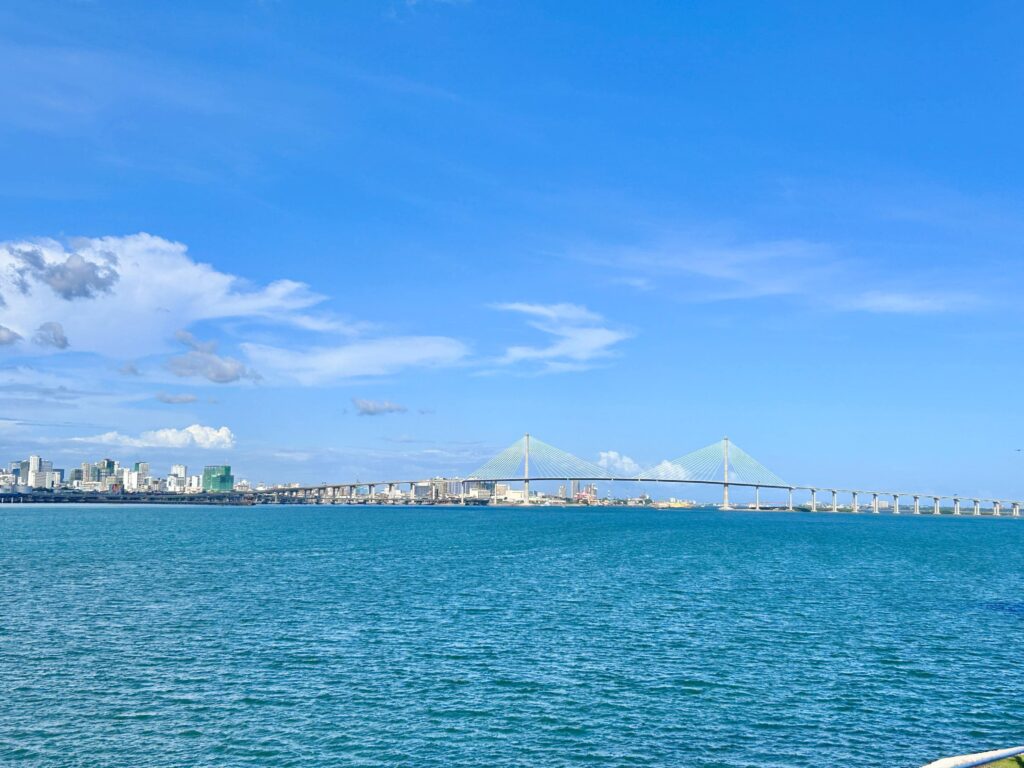
A picturesque view featuring the CCLEX and some high-rise buildings in Cebu City. | CDN Digital photo by Niña Mae Oliverio
CEBU CITY, Philippines — Cebu has proven its economic standing in the region once again as it remains to be the largest economy in Central Visayas.
The Philippine Statistics Authority (PSA) conducted on Thursday, Nov. 28, a simultaneous dissemination report of the 2023 Provincial Product Accounts (PPA) in its regional and provincial offices.
Engr. Leopoldo P. Alfanta, Jr., chief statistical specialists of PSA-7 and Cebu Province, and Melchor Bautista reported that Cebu Province and the three highly urbanized cities in Cebu posted a positive economic performance in the 2023 PPA.
The economy of Cebu Province grew by 6.0 percent, while the cities of Cebu, Lapu-Lapu, and Mandaue grew by 8.3 percent, 9.4 percent, and 7.6 percent, respectively. The three major sectors that contributed to the region’s economy were industry, services, and agriculture, forestry, and fishing (AFF).
READ MORE: CV records ‘fastest growing economy’ among all regions in PH
Cebu Province
In Central Visayas, Cebu Province still had the largest economy with 29.8 percent share to the total economy of the region. It also observed a faster growth in 2023 than in 2022, Bautista said.
From P388.06 billion in 2022, the province’s economy grew to P411.32 billion in 2023.
Cebu City was the second largest economy in the region with 22.6 percent share. The third was Bohol with 13.2 percent share. The province of Negros Oriental ranked fourth with 12.9 percent share, Lapu-Lapu City ranked fifth with 12.0 percent share, and sixth was Mandaue City with 8.5 percent share, and last was Siquijor with 0.9 percent share.
The sector that has the largest share was the services with 62.0 percent, followed by industry with 29.1 percent share, and last was the AFF with 8.9 percent share.
READ MORE:
3 cities in Cebu in top 10 provinces, HUCs list with high economic growth in 2022
Wholesale, retail trade among the top contributors to Cebu tri-cities’ economy
Central Visayas to lose 14% of economy as NegOr, Siquijor join Negros Island Region
3 HUCs
In terms of level, the value of the gross domestic product (GDP) of Cebu City was estimated at P312.71 billion in 2023 from P288.77 billion in 2022. Meanwhile, Lapu-Lapu City’s GDP was P165.61 billion from P151.44 billion in 2022.
Lastly, the GDP of Mandaue City increased from P109.62 billion in 2022 to P117.99 billion in 2023. All of the three major industries posted growth in 2023, Alfanta said.
In the cities of Cebu and Mandaue, services had the largest share to their economies with 89.7 percent share and 68.3 percent share, respectively. The services in Lapu-Lapu City have 49.2 percent share.
Meanwhile, in Lapu-Lapu City, the sector that has the largest share was the industry with 50.5 percent share. In Cebu City and Mandaue City, the industry sector has 9.8 percent share and 31.7 percent share, respectively.
The sector that had the lowest share in all the HUCs was the AFF sector where it logged 0.5 percent in Cebu City, 0.3 percent in Lapu-Lapu City, and 0.03 percent in Mandaue City.
The major industries that contributed to Cebu City’s economic growth were the financial and insurance activities, wholesale and retail trade and repair of motor vehicles and motorcycles; and accommodation and food service activities.
For Lapu-Lapu City, the major industries that contributed to their economic growth were transportation and storage, accommodation and food service activities, and construction.
For Mandaue City, the major contributors were wholesale and retail trade and repair of motor vehicles and motorcycles; accommodation and food service activities; and transportation and storage.
Economic structure
As for the economic structure, wholesale and retail trade and repair of motor vehicles and motorcycles had the largest share in Cebu City’s economy with 26.1 percent share, followed by financial and insurance activities with 20.5 percent share, and real estate and ownership dwellings with 9.0 percent share.
In Lapu-Lapu City, the manufacturing industry has the largest share with 43.3 percent, followed by transportation and storage with 10.6 percent, and wholesale and retail trade and repair of motor vehicles and motorcycles with 9.7 percent.
For Mandaue City, wholesale and retail trade and repair of motor vehicles and motorcycles had the largest share to their economy with 30.2 percent, followed by manufacturing with 24.8 percent, and financial and insurance activities with 11.2 percent share.
Neil Andrew Menjares, chief economic development specialist of National Economic and Development Authority-7, said, that the economic activities in the province had gradually recovered from the impact of the pandemic.
“That was a very significant development because our economic activities are now in full swing, and notably, full in-person classes played a big role because the parents already have a place to deposit their children which is in school. Even the economic managers in the central office also considered that,” Menjares said during the open forum.
The PPA is a systematic approach used by the PSA to compile the GDP using the production approach at the subregional level at a given period of time.
GDP is a comprehensive indicator that measures economic activity. Moreover, it measures the value of all final goods and services produced within the economy in a given period of time.
Knowing the PPA, according to PSA-7 Director Ariel Florendo, is crucial to all policymakers and government agencies so they can assess their programs’ effectiveness.

